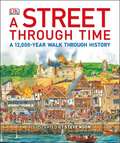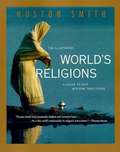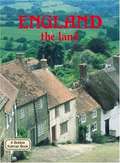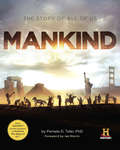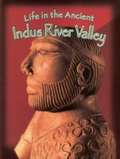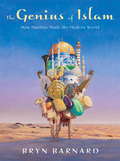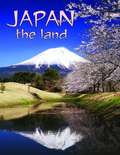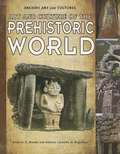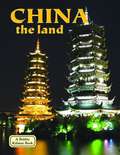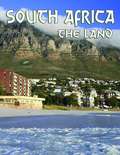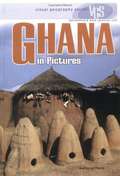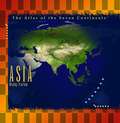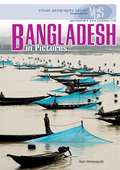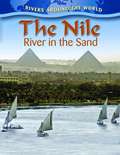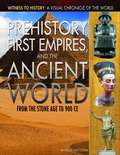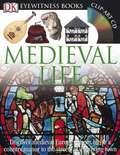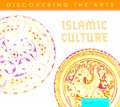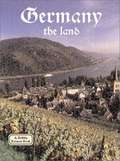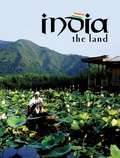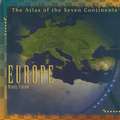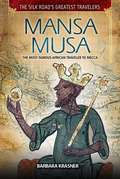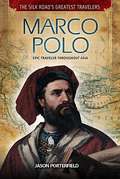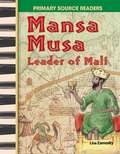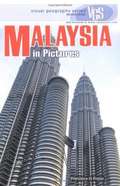Special Collections
District List: NYC Core Curriculum 6th - Social Studies
Description: The New York City Core Curriculum program aims to provide a high-quality curricula to NYC students through a seamless instructional program across grades and subjects. This list has been curated by NYCDOE for 6th Grade Social Studies materials. #nycdoe
- Table View
- List View
A Street Through Time
by Dorling KindersleyThis book views a street by the river through the ages and how it has evolved.
The Illustrated World's Religions
by Huston Smith"In detailed, absorbing, richly illustrated, and highly readable chapters on Hinduism, Buddhism, Confucianism, Taoism, Islam, Judaism, Christianity, and primal religions, we find refreshing and fascinating presentations of both the differences and similarities among worldwide religious traditions."
England
by Erinn BantingEngland's landscape is rich in beauty and dotted with history. From the breathtaking Lake District to the southern downs, take a journey across England.
[This text is listed as an example that meets Common Core Standards in English language arts in grades 4-5 at http://www.corestandards.org.]
Mankind
by Pamela D. TolerIt takes more than 10 billion years to create just the right conditions on one planet for life to begin. It takes another three billion years of evolving life forms until it finally happens, a primate super species emerges: mankind.
In conjunction with History Channel's hit television series by the same name, Mankind is a sweeping history of humans from the birth of the Earth and hunting antelope in Africa's Rift Valley to the present day with the completion of the Genome project and the birth of the seven billionth human. Like a Hollywood action movie, Mankind is a fast-moving, adventurous history of key events from each major historical epoch that directly affect us today such as the invention of iron, the beginning of Buddhism, the crucifixion of Jesus, the fall of Rome, the invention of the printing press, the Industrial Revolution, and the invention of the computer. With more than 300 color photographs and maps, Mankind is not only a visual overview of the broad story of civilization, but it also includes illustrated pop-out sidebars explaining distinctions between science and history, such as why there is 700 times more iron than bronze buried in the earth, why pepper is the only food we can taste with our skin, and how a wobble in the earth's axis helped bring down the Egyptian Empire. This is the most exciting and entertaining history of mankind ever produced.
Life In The Ancient Indus River Valley (Peoples of the Ancient World)
by Hazel Richardson5000 years ago, people built the Harappa city in the Indus valley with clay clad walls, sewage system and trade records! The book is a timeline from the Harappan civilization to Aryans to Mauryas and Guptas.
The Genius of Islam
by Bryn BarnardThe Middle Ages were a period of tremendous cultural and scientific advancement in the Islamic Empire--ideas and inventions that shaped our world.
Did you know that:
The Muslim world has often been a bridge between East and West, but many of Islam's crucial innovations are hidden within the folds of history.
In this important book, Bryn Barnard uses short, engaging text and gorgeous full-color artwork to bring Islam's contributions gloriously to life. Chockful of information and pictures, and eminently browsable, The Genius of Islam is the definitive guide to a fascinating topic.
Japan The Land
by Bobbie KalmanThis revised and beautifully designed new edition covers every aspect of Japan's geography, natural resources, agriculture, and landforms.
Updated photographs and information on topics such as modern industry, new approaches to pollution and recycling, and high-speed trains are included.
Art And Culture Of The Prehistoric World
by Beatrice D. Brooke and Roberto Carvalho de MagalhãesWe know a surprising amount about how people lived before the written word. This strikingly visual book combines photographs of artifacts created by ancient humans with brilliant illustrations, and is guaranteed to appeal to students of all ages. Readers learn about the lives of early humans, from the invention of tools to their religious beliefs. They'll see that we've been a highly inventive species all along.
China
by Bobbie KalmanThe book discusses China's economy and the reforms that have happened and the status of Hong Kong and Taiwan.
South Africa - The Land
by Domini ClarkIn South Africa you can see some of the most fascinating animals in the world, amazing mountains with steep cliffs and flat tops that rise above deep gorges, waterfall carved caves and tunnels through rock, and areas of flat land that stretch farther than the eye can see.
Ghana In Pictures
by Yvette La PierreIntroduces through text and photographs the land, history, government, people, and economy of Ghana.
Asia
by Wendy VierowAtlas of the Seven Continents contains amazing continental maps and detailed information on population, beliefs, climate and vegetation, ecology and environment, economy, and politics and history. This is the best book for Geography class and for anyone who need information about any continent on Earth. Describes the continents in great detail!
Bangladesh
by Thomas StreissguthAn overview of Bangladesh's geography and history, along with an exploration of the political, economic, and cultural landscape of this country in South Asia.
The Nile
by Molly AloianThe Nile is the world's longest river and the birthplace of one of the greatest civilizations of the ancient world.
This book takes readers along the "River in the Sand." Ancient Egyptians depended on the Nile's annual floods to deposit fertile soil for farming.
Today, more than 70 million people still grow crops in the river's basin and fish in its waters.
Prehistory, First Empires, and the Ancient World
by Markus HattsteinReaders will be intrigued by this stunning edition, which provides an overview of periods that are less readily studied in the classroom. Readers will be excited to experience prehistory, the Stone Age, first empires, and ancient worlds. With detailed images, this curated guide of the early parts of our civilization will make all study engaging and entertaining.
Medieval Life
by Andrew Langley and Dorling Kindersley Publishing StaffEyewitness: Medieval Life gives the reader an in-depth look at life from the end of the Dark Ages to the Renaissance in the 15th century, in both the town and the country, and for the peasants as well as the aristocracy. Featuring artifacts, costumes, furniture, and historical illustrations, Medieval Life is a unique and compelling introduction to the people and culture of the Middle Ages.
Islamic Culture
by Atif ToorThis book describes Islamic art, from the building of the Dome of the Rock in Jerusalem in 691 to the work of Pakistani artist Shahzia Sikander, who expresses modern ideas in her miniature paintings.
Germany the Land
by Kathryn LaneIntroduces the geography, cities, transportation, economy, and wildlife of Germany.
India the Land
by Bobbie KalmanUpdated facts and statistics highlight this new second revised edition of India the Land. Spectacular photographs feature India's varied geography from snow-covered mountaintops to tropical rainforests. Learn about India's major cities, its disputed borders, foreign influences, and current challenges
Europe
by Wendy VierowEurope, the second smallest continent on Earth, has 43 countries. Some geographers consider Europe part of a landmass that includes Asia, called Eurasia. Actually, it is a large peninsula, or mass of land that is surrounded on three sides by water. Europe s climate ranges from frozen tundra to warm Mediterranean. The first great civilization in Europe reached its height in Greece about 2,500 years ago. Since then, empires have risen and fallen in Europe. Today, many different ethnic groups call Europe home.
Mansa Musa
by Barbara KrasnerFrom Mali to Cairo to Mecca and beyond, Mansa Musa was known as the Lion of Mali. Now remembered as the richest person in history, his enormous wealth, legendary generosity, and lavish pilgrimage from Mali to Mecca made him a favorite of medieval Arab storytellers. However, the 14th-century leader also presided over one of the largest empires in the world during his time. This informative biography traces Mansa Musa’s life, following his magnificent caravan as he traversed what remained of the Silk Road routes to become a hajji and returned to transform Timbuktu into western Africa’s most famous cultural center.
Marco Polo
by Jason PorterfieldUpon returning to his native Venice from a nearly 25-year journey through Asia, Marco Polo fueled the Western imagination with his tales about the splendors of the East. This lively biography follows Marco’s intrepid family as they navigate the spice stalls, caravansaries, and dangers that once populated the Silk Road and enter Kublai Khan’s Mongol court in China, where they served as advisors. Readers will learn about the Polos’ importance as cultural emissaries at a time of limited global exchange and how Marco’s account of their travels—whether fact or fiction—heralded the later golden age of exploration.
Mansa Musa
by Lisa ZamoskyMansa Musa was the king of Mali as it became one of the largest empires during the time of Musa's rule. Readers will discover the life of Mansa Musa in this appealing biography that uses vivid images, appealing maps, and stunning facts to engage children. A glossary and index work in conjunction with the easy-to-read text to teach readers about the Mali ruler, griots, Mali trade, Mecca, Malian religion, and other kings and queens
Malaysia in Pictures
by Francesca Di PiazzaIntroduces the geography, history, religious beliefs, government, and people of Malaysia.
